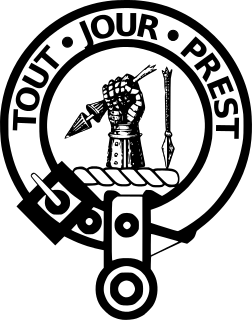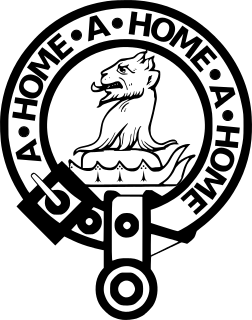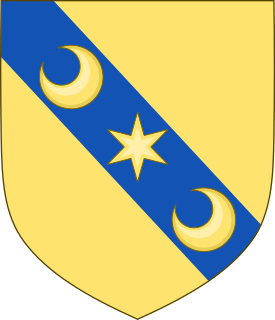
Bothwell Castle is a large medieval castle, sited on a high, steep bank, above a bend in the River Clyde in South Lanarkshire, Scotland. It is located between Bothwell and Uddingston, about 10 miles (16 km) south-east of Glasgow. Construction of the castle was begun in the 13th century by the ancestors of Clan Murray, to guard a strategic crossing point of the Clyde. Bothwell played a key role in Scotland's Wars of Independence, changing hands several times.

Clan Kerr is a Scottish clan whose origins lie in the Scottish Borders. During the Middle Ages, it was one of the prominent border reiver clans along the present-day Anglo-Scottish border and played an important role in the history of the Border country of Scotland.

Clan Maxwell is a Scottish clan of the Scottish Lowlands and is recognized as such by the Lord Lyon King of Arms. However, as the clan does not currently have a chief, it is considered an armigerous clan.

Clan Scott is a Scottish clan and is recognised as such by the Lord Lyon King of Arms. Historically the clan was based in the Scottish Borders.
Andrew Rutherford, 1st Earl of Teviot was a Scottish soldier.
The Raid of the Redeswire, also known as the Redeswire Fray, was a border skirmish between England and Scotland on 7 July 1575 which took place at Carter Bar, the Cheviot pass which enters Redesdale. The skirmish was between the English Warden of the Middle Marches, Sir John Forster, with Sir George Heron, Keeper of Redesdale, Keeper of Liddesdale and Scottish Warden and Sir John Carmichael, the Lord Warden of the Marches, with George Douglas of Bonjedworth. It was the last battle between the Kingdom of England and the Kingdom of Scotland.

Clan Carmichael is a Scottish clan and is also considered a sept of the Clan Douglas, Clan MacDougall, Stewart of Appin, and Stewart of Galloway.

Clan Home is a Scottish clan. It held immense power for much of the Middle Ages and dominated the eastern Scottish Borders. It produced no fewer than eight Wardens of the Eastern March – more than any other family.

Clan Johnstone is a Border Reiver Scottish clan.

The Anglo-Scottish border is a border separating Scotland and England which runs for 96 miles (154 km) between Marshall Meadows Bay on the east coast and the Solway Firth in the west. The surrounding area is sometimes referred to as "the Borderlands".

Sir Walter Scott, 1st of Branxholme, 3rd of Buccleuch, known as "Wicked Wat", was a nobleman of the Scottish Borders and the chief of Clan Scott who briefly served as Warden of the Middle March He was an "inveterate English hater" active in the wars known as The Rough Wooing and a noted Border reiver. He was killed on Edinburgh High Street in a feud with Clan Kerr in 1552. His great-grandson was Sir Walter Scott, 1st Lord Scott of Buccleuch, the "Bold Buccleuch" (1565–1611), a border reiver famed for his role in the rescue of Kinmont Willie Armstrong.
Sir John Carmichael was a Scottish soldier, the Keeper of Liddesdale, a diplomat, and owner of Fenton Tower at Kingston, East Lothian.

Edgerston is a village and an estate about 4 miles (6.4 km) north of the Anglo-Scottish border, and 8 miles (13 km) south of Jedburgh in the Scottish Borders area of Scotland in the former Roxburghshire.

Bonjedward is a hamlet in the Scottish Borders area of Scotland, two miles north of Jedburgh where the Jed Water joins the River Teviot.

William Eure, 1st Baron Eure (c.1483–1548) of Witton was an English knight and soldier active on the Anglo-Scottish border. Henry VIII of England made him Baron Eure by patent in 1544. The surname is often written as "Evers". William was Governor of Berwick upon Tweed in 1539, Commander in the North in 1542, Warden of the Eastern March, and High Sheriff of Durham. During the Anglo-Scottish war called the Rough Wooing, Eure and his sons Henry and Ralph made numerous raids against towns and farms in the Scottish Borders.

Cavers Castle, also known as Cavers House, is a ruined tower house located at Cavers, Scottish Borders, Scotland. Cavers Castle was a much extended tower house of the Douglas family dating back to the 15th or 16th century, and built upon the site of an earlier stronghold of the Balliols. It was repeatedly attacked during the 16th century wars with England, and substantially remodelled in the 17th century to form a mansion house, itself extended and remodelled in baronial style by Peddie and McKay in the 1890s. It was eventually deroofed and partially demolished in the 1950s, and was sold most recently in 2019. There are developing plans to restore the building, which is a listed building.

Mangerton Tower is a ruined Scottish tower castle house formerly belonging to the Armstrong family.
Major John Rutherfurd of Edgerston was a Scottish soldier and politician.
John Rutherfurd of Edgerston was a Scottish soldier and politician.
Sir Robert Rutherfurd was a Scottish merchant who was made a Baron of the Russian Empire.














